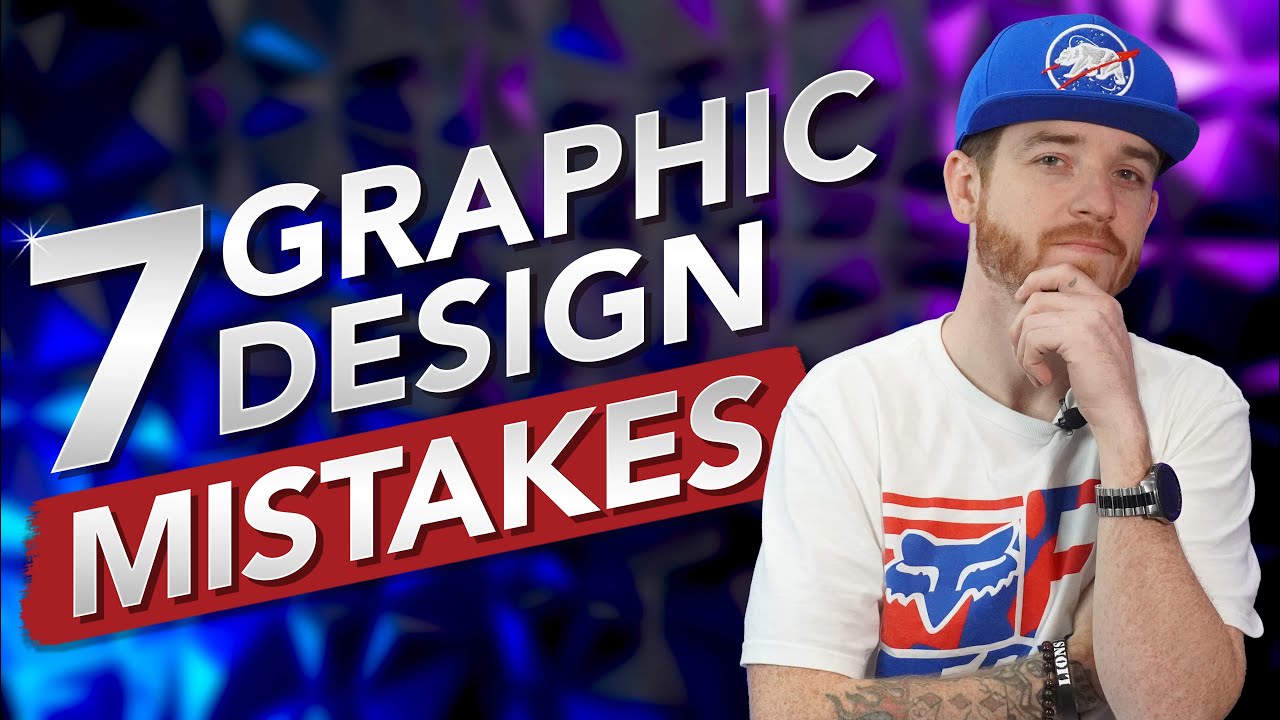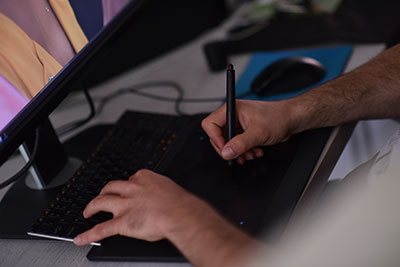
We have all seen them: truly egregious graphic design fails that make us cringe and wonder how the designer could have made such a mistake. Likewise, there are subtle fails floating around the marketplace as well—just “off” enough to irk any designer who lays eyes upon them but not enough to attract client scrutiny. Unfortunately, these mistakes are all too common in the graphic design industry. In order to help you avoid making the same mistakes, I have compiled a list of the seven deadly sins of graphic design. So read on, and learn from other people’s graphic design fails (like mine) so that your designs will look great every time!
Everyone Has Graphic Design Fails

Becoming a Better Designer Helps Avoid Graphic Design Fails
The first step to becoming a better designer is going to be learning how to become better at design. If you stick with me throughout this article, I’m going to share seven steps with you that are going to help you do just that. Make sure you get a pen and paper and take some notes because you’re going to want to apply these not just hear what I have to say. I’ve seen some work recently shared by a lot of different graphic designers, and I keep seeing these same mistakes come up time and time again.
I wanted to point out these mistakes and that’s what inspired this article: understanding what are these common mistakes people are making, and how you can avoid them from making your work look cheap or underpaid or undervalued or just subpar. That’s probably why people aren’t hiring you and why you’re not getting enough client work. So the first step in that is to increase your skills. The first way you can do that is by reading articles like this and learning what mistakes not to make. There’s one thing to learn what to do, but it’s also important to learn what not to do.
Pay Attention to What the Market Wants or Graphic Design Fails Await
The second reason why I think people aren’t hiring you is that you’re not paying attention to what the market wants. So many creatives are just doing what they want to do, rather than what the market is paying for. That is a sure-fire recipe for graphic design fails. This is a really important element to this point I want to make: you need to follow the demand. If there are other graphic designers that you look up to and respect, and you don’t, you need to find some that are doing similar type of work that you’re doing.
When I started my career in 2006 or 2007, I modeled fellow graphic designers who were doing nightlife flyers and promotional flyers. I copied the same styles and elements in their work. So follow what the market is paying for – don’t just create something because you think it looks good.
Share Your Work With More People to Prevent Graphic Design Fails
So let’s get to the third reason why I think people are not hiring you – because you’re not showing your work to enough people. How many people are you making offers to on a daily, weekly, monthly and even yearly basis? If you don’t have numbers, if you don’t have a plan in place, this is an area that’s hurting you. You need to be going out there and sharing your work. We have a gentleman that’s inside of our Instagram Pro Network that does billboard designs; he knows who this is, he knows who he is – he’s reading this article, I’m sure.
He is constantly sharing his work on his Facebook and Twitter, on all these different social profiles. He’s sharing the work that he does over and over again, and his work is beautiful. People are seeing it, and he’s building momentum that way. Your work is your social proof; it’s a form of social proof which means it’s proof that you do really good work. If you have the skill sets, people are going to seek you out. And if you do that consistently, it’s going to lead people back to you – this is a really important point. You need to be sharing your work on a daily basis; you’re doing tons and tons of projects, and you may not be leveraging this opportunity.
The 7 Graphic Design Fails To Avoid

Overusing Layer Effects
The first of our graphic design fails is overusing layer effects. This specifically applies to Photoshop more than Illustrator, but inside of Photoshop they have layer effects and layer effects are an important piece of actually designing and incorporating designs into your work. I see them constantly being overused. Your biggest issue is that you’re doing too many layer effects, bevels and embosses, textures and gradients, drop shadows and outer glows, inner shadows and strokes, and all these different things.
If you put all of those on there, it’s going to look hideous. You only need to add one or two layer effects to your designs now, typography specifically is even more important because you can easily make text look cheesy, blurry, and just not look great. Think about things as a simplified, clean, and crisp layout – you want your text to be easily read, and the more effects you add to it, the harder it will be to read. The messaging is the most important part of your design, so don’t overuse layer effects. Keep it simple when it comes to your layer effects.
Poor Contrast
The second graphic design mistake you should not make and I see this all the time is poor contrast. Either contrasting too much or not contrasting enough, I saw a design recently that had a brown background, and then it had lighter brown lettering and I found myself asking, what is this person thinking? You can’t see it – it’s not visible.
Then, the opposite angle of that is doing a white background with black pitch black text. This is a common mistake I see people make often: they’ll take a light blue text with a dark blue background and the contrast is just not there. Making sure that your contrast is appropriate is really really important, so keep it simple.
Poor Color Palettes
Number three is a big one: poor color palettes. I see people mixing colors that have no business being on the same canvas. Do not do this! This is a big mistake. And if you’re not using a color palette tool to find your monochromatic and triad and complementary and triad complementary and all the different effects, there’s a really neat tool that I want you to have. This is a free gift for you you can check it out; it’s called Coolors.
It allows you to make really neat color palettes. I actually did this for my own brand, where I put my main A42027 code in there. You can do different shades and pick different combinations where you can generate a color code. I use blue as part of my color code, but I use a light white or almost a white kind of an off-white. I use a couple different shades of my red and this is a really important tool to use to make sure that your colors actually scientifically match.
If you’re pairing orange and green, you’re going to get Halloween. If you compare green and red, you’re going to get Christmas. And if you aren’t going for holiday vibes, you’ve just made some garish graphic design fails. A lot of people do this and they don’t really understand color psychology, so you need to understand two really important things when it comes to color palettes: color psychology and color pairing. Pairing the right colors together is a major deal if you don’t do this right; it’s one of the quickest things that can make your look or design work look amateurish.
Outdated Typography and Pairing

You also want to make sure that you pair your fonts correctly. Try not to do a serif with a sans serif most of the time that doesn’t work out very well. Keep a consistent font on your design if you’re using three, four, or five fonts on one design, your design is going to go downhill very quickly with each font that you add. I usually recommend no more than two fonts on the design. So this is something I want you to understand: don’t use old-school fonts; use something new and fresh. And don’t pair old fonts with new fonts – just keep it consistent. Consistency is the key.
Busy Backgrounds
Graphic design fails, number five: I hope you’re ready for this one because this is a very common one I see. Probably more than almost any other mistake, people make backgrounds that are too complicated and cluttered. I see people trying to blend black and white photos into the background, multiple images into the background, and cut-out photos and cropped photos. Keep your background simple – don’t do gradients in your background, keep it one consistent color. You can use textures, but make sure they’re simple textures.
If you need to blend a busy texture and reduce its opacity so that it’s not overpowering and taking away from the context and message of your design, I’ve used wood backgrounds in the past and that has helped. However, I’ve also cut down the opacity or blended it in a way that didn’t take away from the messaging. You want to stay away from busy backgrounds and keep it simple, so focus on the content, not just the design.
Too Much Content
Graphic design mistake number six that you should not make is usually on the client side, but it’s your job as the content creator and graphic designer to make sure that your content and verbiage are on point. What do I mean by on point? A lot of people put too much content and try to stuff it full of so much information. It is absolutely necessary to have a clear objective for this marketing piece, and when people don’t have a clear objective, it’s a dead giveaway by their content. They just fill it in with as much information as possible and a lot of really great graphic designers that I’ve seen will simplify the messaging and take away less. This is more effective because it keeps it simple – what is the main outcome that you want from this marketing piece? What is the objective?
There’s a lot of information that can be given after the fact, meaning after they’ve engaged. What is the minimum amount of information that they need to be able to take this action? How do you compel them to take the desired action? Putting out a whole paragraph worth of information at the bottom of a flyer or five paragraphs on a one-page flyer is too much information. You just need to give them enough to want more. Always leave them wanting more. Never going, “Oh my gosh, this is too much.” If you give them too many options and too much information – they’ll just go in a different direction because they’re confused and overwhelmed. This is an important mistake that I don’t want you to make.
No Hierarchy
The last one is the last, but not least. And that is the hierarchy: this is the last graphic design mistake that I see people commonly make as they size everything the same, or some of the most important information is too small, while some of the stuff that is irrelevant is too big – like a grand opening. Okay, that’s cool – that’s an important piece. But does that need to be the biggest thing on the flyer? Maybe the phone number should be the biggest thing on the flyer, or on the website. Whether you’re doing a website, flyer, or business card, some people take business cards and put logos on them that cover three quarters of the size of the card. The contact information on the business card is most important, so understanding the hierarchy of what needs to be where and positioned in what spot is critical.
Just to give you a quick example, when I started designing club flyers, one of the methodologies that I used for hierarchy was to design the flyer and format the content and layout of that flyer as if I were reading it on a radio ad, a tv ad, or some sort of online ad. This gave me the event information that they needed first and foremost, December 22nd blah blah blah whatever it’s “ABC Company presents”, and then the name of the event.
So you’d have the date of the event up top, as the first thing they need to know. They go, “Okay, I’m busy that day.” This company is presenting it, so they go, “Oh, I’ve heard of that company.” Then, boom! Here’s the name of the event. Below that, you might have some cool images or bullet points. Specials would be much smaller text. And finally, down at the bottom is where your contact info would go. How do you take the next step? What is the call to action? Whether it’s a website, where to get tickets, what the ticket price is, certain information like that – format it just like if you were reading it on the radio or TV, or on some sort of online ad. You want it to read naturally, as they’re going through it. A natural hierarchy.
Final Thoughts on Graphic Design Fails

